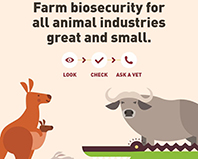Read the latest information on
Foot-and-mouth disease
 Whilst sheep, cattle, chickens and pigs are the bread and butter of Australia’s livestock production, there are a host of other unique livestock sectors across the country that contribute to the economy and also require good on-farm biosecurity and emergency animal disease preparedness.
Whilst sheep, cattle, chickens and pigs are the bread and butter of Australia’s livestock production, there are a host of other unique livestock sectors across the country that contribute to the economy and also require good on-farm biosecurity and emergency animal disease preparedness.
Animal Health Australia (AHA) has teamed up with Charles Sturt University to develop biosecurity resources and emergency animal disease preparedness information for new and emerging livestock industries including emu, turkey, dairy sheep, buffalo, deer and harvesting industries including kangaroos, just to name a few. The project, which is being funded by the Rural Industries Research and Development Corporation commenced with research undertaken by the university and led by Senior Lecturer for Veterinary Epidemiology and Public Health, Dr Marta Hernandez-Jover.
Dr Hernandez-Jover reaffirmed that there was a need for better biosecurity information for these unique industries. “Our research revealed that most new and emerging industries want biosecurity information, but we need to provide a tailored approach to engaging with and developing materials for them,” Dr Hernandez-Jover said.
AHA’s Executive Manager Biosecurity, Duncan Rowland, said farm biosecurity is an integral component of production when developing new and emerging industries and we aim to provide the information these producers need. “It doesn’t matter whether you farm crocodile, deer, sheep, pigs, camels, turkey or buffalo; all livestock producers face similar biosecurity risks when it comes to stock, vehicles, feed, materials and people moving on and off your property or the risks inherent in everyday production practices,” Mr Rowland said.
“The difference lies in the unique nature of our new and emerging industries which are dotted sparsely across the country and in some cases face additional or unique risks that are realised as the industry grows. “The Farm Biosecurity Program is here to help. Producers of new and emerging livestock sectors are encouraged to visit the dedicated New and Emerging Industries web page where they can get tips about biosecurity with videos, fact sheets and posters. Producers should also subscribe to the monthly e-newsletter, through the link on the top right-hand side of the Farm Biosecurity home page,” Mr Rowland said.
Livestock industries covered in this project include: Alpaca, Buffalo, Camel, Crocodile, Dairy goat, Dairy sheep, Deer, Duck, Emu, Fibre goat, Turkey, Game bird, Kangaroo, Marron, Ostrich, Rabbit and Redclaw